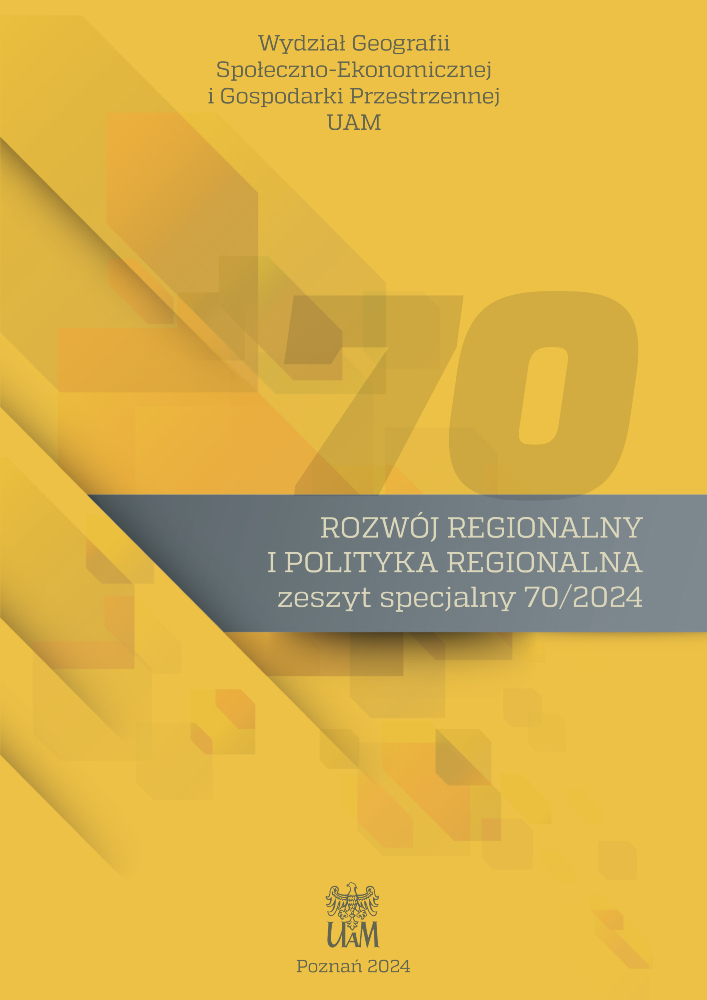Abstract
The article presents changes in housing attractiveness in 66 cities with district rights in Poland as at the end of 2022 compared to the end of 2019. Using the method of comparative analysis, simple statistical methods (the method of indicators, the ranking method) and the descriptive method, changes in the values of selected variables regarding local labor markets and residential real estate were examined against the background of population changes. The COVID-19 pandemic and its consequences, including: remote work, searching for places to live with a high quality of life or cheaper housing properties has resulted in an increase in interest in some cities, which provides a chance for population growth. During the period under study, this had an impact on the results for some groups of cities divided into quartiles in terms of population changes, while in the case of others, certain symptoms were noticed that may develop in the future. The determinants of the increase in the housing attractiveness of cities may be expansive local housing policy and friendly policy towards investors.
The observed changes were also influenced by the inflow of people from Ukraine, especially present in the largest cities and those located close to the eastern border of Poland. Among the cities with district rights, 29 are medium-sized cities (approx. 44% of the surveyed cities), in the 3rd quartile (low population decline), there are 8 medium-sized cities (mainly with a developed tourist function or being part of the Upper Silesian Agglomeration), in the 4th quartile (very low population decline or increase) there were 2 medium-sized cities. Cities, in order to stop the depopulation trend and the loss of functions, must attract people. An opportunity, among others, cities located in the east of the country experienced an influx of immigrants from Ukraine. However, in order to maintain this tendency, it is necessary to pursue a local housing policy and have a clear strategy towards investors. Students and graduates can also be a stimulant, provided that attractive conditions for living (staying) in the city are created, related to the potential of the local labor market and the local housing real estate market.
References
Bank Danych Lokalnych Głównego Urzędu Statystycznego (GUS) (https://bdl.stat.gov.pl/bdl/start; dostęp: 29.12.2023).
Budner W.W., Pawlicka K. 2013. Ocena innowacyjnej architektury Poznania a wzrost atrakcyjności miasta. Acta Scientiarum Polonorum Administratio Locorum, 12(2): 5-20.
Chojnicki Z. 1977. Dylematy kwantyfikacji geografii. [W:] Z. Chojnicki (red.), Metody ilościowe i modele w geografii. PWN, Warszawa, s. 9-15.
Czyż T. 2016. Metoda wskaźnikowa w geografii społeczno-ekonomicznej. Rozwój Regionalny i Polityka Regionalna, 34: 9-19.
Florida R., Rodriguez-Pose A., Storper M. 2021. Cities in a post-COVID world. Urban Studies, 60. DOI: https://doi.org/10.1177/00420980211018072
Gehl J. 2013. Cities for People. Island Press.
Gwosdz K., Sobala-Gwosdz A., Górecki J., Jarzebiński M., Rotter-Jarzebińska K., Fiedeń Ł. 2019. Potencjał miast średnich w Polsce dla lokalizacji inwestycji BPO/SSC/IT/R&D. Analiza, ocena i rekomendacje. Związek Liderów Sektora Usług Biznesowych (ABSL), Ministerstwo Inwestycji i Rozwoju, Warszawa.
Heffner K. 2023. Trendy migracyjne i ich znaczenie dla strategii rozwoju regionalnego – przykład województwa opolskiego. [W:] B. Solga (red.), Migracje i rozwój regionu. Materiały z III Kongresu Demograficznego. Cz. 7. Warszawa, s. 67-93.
Janas K., Piech K., Trzepacz P. 2019. Współczesne i prognozowane przemiany ludnościowe polskich miast. [W:] Przemiany demograficzne miast Polski. Wymiar krajowy, regionalny i lokalny. Krajowy Instytut Polityki Przestrzennej i Mieszkalnictwa, Warszawa, s. 23-40.
Kaczmarek T. 2020. Różne oblicza suburbanizacji. Od przedmieść w cieniu miasta do post-suburbiów. Prace i Studia Geograficzne, 65(3): 103-113.
Kolenda M. 2001. Porównywanie metod rangowania obiektów. Badania Operacyjne i Decyzje, 2: 61-76.
Krystek-Kucewicz B., Kaszuba K. 2017. Polityka mieszkaniowa jako narzędzie ograniczania depopulacji: wybrane instrumenty stosowane w polskich miastach. Konwersatorium Wiedzy o Mieście, 30(2): 43-57. DOI: https://doi.org/10.18778/2543-9421.02.05
Mierzejewska L., Parysek J. 2021. Porządne miasto porządnych mieszkańców. Studia Miejskie, 39: 11-27. DOI: https://doi.org/10.25167/sm.2064
Nowak K., Muzioł-Węcławowicz A. 2023. Miasta jako inwestorzy mieszkaniowi. Instytut Rozwoju Miast i Regionów, Warszawa-Kraków. DOI: https://doi.org/10.51733/opm.2023.15
Ramani A., Bloom N. 2021. The Donut Effect of Covid-19 on Cities. Working Paper, 28876 (http://www.nber.org/papers/w28876). DOI: https://doi.org/10.3386/w28876
Warżała R. 2022. Zmienność koniunktury w warunkach regionalnej depopulacji – wzajemne związki i oddziaływania w ujęciu lokalnym. [W:] A. Organiściak-Krzykowska, J. Hrynikiewicz (red.), Depopulacja w ujęciu lokalnym. Materiały z III Kongresu Demograficznego. Cz. 3. Warszawa, s. 80-90.
Wiśniewski R., Mazur M., Śleszyński P., Szejgiec-Kolenda B. 2020. Wpływ zmian demograficznych w Polsce na rozwój lokalny. Prace Geograficzne IGiPZ PAN, 274. Warszawa. DOI: https://doi.org/10.7163/9788361590837
License
Copyright (c) 2024 Alicja Zakrzewska-Półtorak

This work is licensed under a Creative Commons Attribution 4.0 International License.

